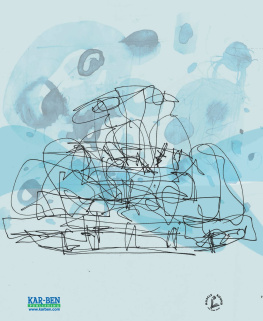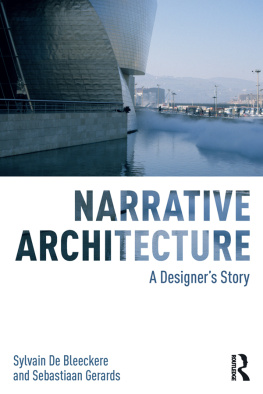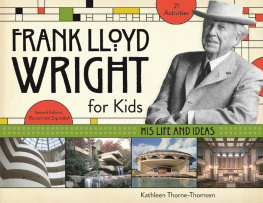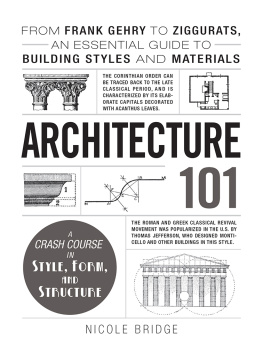Acknowledgments
N o book is the work of just one person, and that is particularly true of a book such as this one. I have spent my life writing about architecture, but writing about someones work is not the same as writing about his life, and I have been learning the craft of biography as I have progressed through my research on Frank Gehry. So it feels right to acknowledge a certain debt to other biographers. I have learned much both from writers of the past like Lord David Cecil and biographers of our time, like Robert Caro, Jean Strouse, Richard Ellmann, David McCullough, Maynard Solomon, Walter Isaacson, Adam Begley, Ron Chernow, Stacy Schiff, and Mark Stevens and Annalyn Swan.
My greatest debt, of course, is to this books subject, who has given of his time and energy with extraordinary generosity and goodwill, all the more noteworthy because it had been agreed that he could have no editorial control over the text. This biography is authorized in the sense that Frank Gehry has cooperated with me in my research, but it has not been written subject to his approval or review.
As I said at the beginning of this book, Frank Gehry and I have been talking on and off for more than four decades, but when I embarked on this project it seemed important to try to give our conversations less randomness, and to review the events of his life in sequence from his childhood through to the present. For the first time, I recorded our sessions together. It is not always easy to struggle through the haze of memory, particularly when the recollections are not all happy ones, and I cannot express my gratitude deeply enough to Frank Gehry for his willingness to embark on this long process, and then to clear his overcrowded schedule whenever I made my way to his home base in Los Angeles. Over the years we met for countless hours in his office, at his home, in restaurants, and on airplanes, sometimes with family members and colleagues, but most often just the two of us. One conversation took place on his sailboat, Foggy, captained by the architect Greg Lynn, as we traveled from Marina del Rey to Malibu and back again. Another took place in the lobby of the George V hotel in Paris. And much as I like the lively buzz of many of Los Angeless trendy restaurants, I have come, like Gehry, to value the peace and quiet, if not the dcor, of the Pacific Dining Car, the old-fashioned place not far from his house in Santa Monica where we have talked over more breakfasts, lunches, and dinners than I could count. Gehrys warmth was always present, and so, I should say, was his wit. It may have been during one of those conversations that he told me he had come up with a perfect title for this book: You should call it Goldberger on Goldberg, he said.
Our conversations always had substance to them, although I am struck, looking back at the transcripts, by how rarely I succeeded in my intention of having our interviews proceed in orderly fashion through his life. And there is a reason for this. Like many people who succeed in working actively into old age, Frank Gehry lives very much in the present, and talks most comfortably about what he is doing right nowor, more to the point, what he hopes to be doing next week, next month, and next year. Looking back is not his favorite thing to do. As a result, almost every one of our meetings began with a lively discussion about what was occupying his mind at the moment, and only after he had warmed up, so to speak, did he begin to delve into his memory. I mention this only because it revealed something essential about him: that while he is proud of his life and his accomplishments, he is driven by what comes next, and that he has no desire to live in the past.
The people closest to him have been equally generous in sharing both their time and their thoughts. I owe a deep debt to Berta Gehry, who has responded to every request with the easy grace she is known for. Alejandro and Samuel Gehry, and their wives, Carrie and Joyce, have been consistently warm and helpful, as has Doreen Gehry Nelson, who offered great insight into her parents and grandparents as well as important recollections spanning all of the familys decades in Los Angeles. Early on in this project, Doreen hosted me for a wonderful dinner at her home, where we pored over old family photo albums. When we discovered we would both be in Paris for the opening of the Fondation Louis Vuitton in 2014, she brought an antique locket of her mothers containing childhood photographs of her and her brother, which she had just discovered, all the way across the world to show me.
Richard Snyder, Franks former brother-in-law, erstwhile lawyer, and now close friend, and Paul Vincent Wiseman have been extraordinarily generous and candid with their insights, and not the least of the pleasures of this project is the friendship that has grown between us. I consider it a privilege to have come to know them both. It is telling that Gehry wanted me to speak with his first wife, Richard Snyders sister, saying that you shouldnt hear that story only from my side, and I regret that Anita Brenner declined my request to talk about her ex-husband. Thanks to Richard Snyders help, I believe the story of their marriage is told fairly.
Frank Gehrys office has been as helpful as his family. Meaghan Lloyd has helped in innumerable ways through the entire history of this project, and I am deeply grateful to her for her logistical help, her sharp insights, and her warm demeanor. Stephanie Pizziorni, Samantha Messick, Diana Ward, and Amy Achorn, his assistants, have responded to my frequent requests with courtesy and promptness, as have Joyce Shin and Jill Auerbach, who helped navigate through the sprawling Gehry office archives and photo files. Many of Gehrys present and former architectural colleagues have helped in other ways, including making time to talk about their experiences with him: my thanks to Craig Webb, Edwin Chan, Michelle Kaufmann, David Nam, Paul Lubowicki, Brian Aamoth, Anand Devarajan, Jim Glymph, Randy Jefferson, John Clagett, John Bowers, Laurence Tighe, Tensho Takemori, Dennis Shelden, Jennifer Ehrman, and Michael Maltzan. Gregory Walsh is more than a former colleaguehe has been a part of Frank Gehrys life for more than sixty yearsand he, too, has been unfailingly generous with his recollections.
The line between Frank Gehrys personal and professional lives has sometimes blurred to the point of invisibility, which suits him. Some of my most important conversations have been with people with whom he has both a professional and a personal connection, most significantly the late Peter Lewis, at whose New York apartment I spent a wonderful afternoon in 2012, as he recounted the story of his unbuilt house and his other Gehry projects; and Thomas Krens, with whom Ive met both in New York and in his extraordinary house in Williamstown to talk about how he and Gehry came together to create the Guggenheim in Bilbao, which could be a book in itself. An evening with Deborah Borda would be a pleasure under any circumstances; talking about Frank Gehry over good wine made it even better. So, too, with lunch at Vitras campus outside Basel, where Rolf Fehlbaum and I spent a memorable afternoon at the Vitra Design Museum and surrounding buildings. Cindy Pritzker graciously hosted me in Chicago to talk about one of her favorite subjects, Frank Gehry, and Michael Tilson Thomas kindly welcomed me to his study in the Gehry-designed New World Symphony Center in Miami Beach where we spoke for several hours about his architect. Larry Field, Larry Ruvo, Richard Koshalek, Richard Weinstein, Richard Cohen, Richard Saul Wurman, Peter Arnell, Marshall Rose, Bruce Ratner, Victoria and Si Newhouse, Elyse and the late Stanley Grinstein, Sidney Felsen and Joni Moisen Weil, Irving and Marilyn Lavin, Juan Ignacio Vidarte, Mark Biass, Gere Kavanagh, and Martin and the late Mildred Friedman are other Gehry friends whose relationships with him began professionally and became warmly personal, and each of them has shared important recollections and insights, as has Greg Lynn, both a fellow architect and a sailing companion. I have learned a great deal from either casual conversations or more formal interviews with Eli Broad, Norman Lear, Bernard Arnhault, Jean-Paul Claverie, Babs Altoon Thompson, Thomas Hines, Nancy Wexler, Ginny Mancini, Michael Govan, Gail Harrity, Nan Peletz, Alan Heller, Adam Flatto, David Weinreb, Nick Vanderboom, John Burnham, Paul Allen, Stephanie Barron, Barbara Guggenheim, Anna Gangbar, Hartley Gaylord, Michele de Milly, Philippa Polskin, Matthew Teitelbaum, Dominic Loscalzo, Rocco Siciliano, Al Trevino, Jack Brogan, Rick Salomon, Barry Diller, and Carol Burnett.









